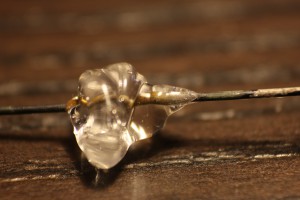Estimate reading time: 2 minutes
The essential matter when making vacuum tubes is good contact of electrodes and glass case, it is called glass to metal seal. It looks simple – just to melt glass, place the hot wire electrode in and wait until it cools down. But there is a problem of different thermal expansion coefficient (TEC), what causes the glass near the connection to crack. So You must use glass and metal with similar TEC.
Soda-lime glass + copper wire
One way is to take ordinary soda-lime glass (TEC 8.5) and choose metal with similar value of TEC, it is often copper (TEC 17) or Dumet wire (I think it is also based on copper). The advantage of using soda-lime glass is that it has lower melting point, so it is easier to form it in proper shape. The main disadvantage is high TEC, so the glass tends to crack easily. Alek zawada is going this way, he mentioned a lots of cracks when dealing with soda-lime glass and copper.
Borosilicate glass + tungsten wire
Borosilicate glass is glass with lower TEC (3.3), it is more resistant to cracking when cooling. A tungsten wire (TEC 4.5) could be used in combination with that glass – it has similar TEC, so it should theoretically produce no cracks 😉 Disadvantage of the tungsten wire is that it can’t be welded to tube’s insides, I haven’t solved that yet.. Tungsten wire is also very hard and the work with it is no comfortable like with copper. But You can expose it directly to the fire when glass forming, it won’t melt unlike the copper. I chose this combination..
Thermal expansion coefficients
| Material | Linear coefficient, α, at 20 °C (10−6/°C) |
||
|---|---|---|---|
| Aluminium | 23 | ||
| Brass | 19 | ||
| Carbon steel | 10.8 | ||
| Copper | 17 | ||
| Diamond | 1 | ||
| Glass | 8.5 | ||
| Glass, borosilicate | 3.3 | ||
| Gold | 14 | ||
| Invar | 1.2 | ||
| Iron | 11.8 | ||
| Kapton | 20 | ||
| Lead | 29 | ||
| Magnesium | 26 | ||
| Mercury | 61 | ||
| Molybdenum | 4.8 | ||
| Nickel | 13 | ||
| Oak | 54 | ||
| Platinum | 9 | ||
| Quartz (fused) | 0.59 | ||
| Rubber | 77 | ||
| Sapphire | 5.3 | ||
| Silicon Carbide | 2.77 | ||
| Silicon | 3 | ||
| Silver | 18 | ||
| Stainless steel | 17.3 | ||
| Steel | 11.0 ~ 13.0 | ||
| Titanium | 8.6 | ||
| Tungsten | 4.5 |
Source: Wikipedia

